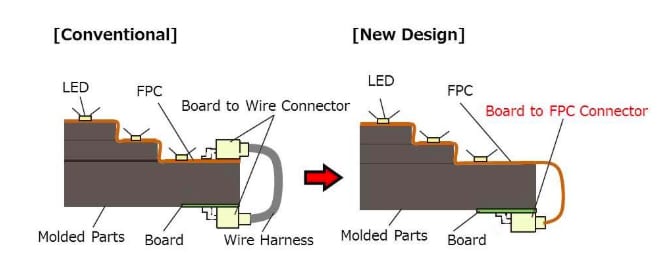Automotive Board to FPC Connector Eliminates Need for Relay Harness
Panasonic Corporation announced that it will commence full-scale mass production of a "Board to FPC Connector" Series called CF1 in July 2019. According to Panasonic, CF1 allows the use of fewer components and results in fewer assembly person-hours for vehicles, and it makes room for improvement in designs of automotive LED lights and other systems.
Due to the growing adoption of DRLs (daylight running lamps) following changes in the laws regulating automotive LED lights in Europe and Japan in recent years and improved designs for vehicle compartment instrument panels, etc., Panasonic asserts that demand for automotive FPCs is expected to grow. This growth will be accompanied by increased use in cable connection applications such as battery management systems (BSMs), the company says.
The novel structure of the FPC connector allows direct connection between the automotive FPC and the board. This connector eliminates the need for wire harnesses previously needed for connection, allowing the use of fewer components and resulting in fewer assembly person-hours.
 Diagram comparing conventional FPC to board connection to Panasonic's new design
Diagram comparing conventional FPC to board connection to Panasonic's new design
The device's unique metal terminal connection structure allows direct connection between the FPC and the board.
Pansonic contends that the connector's double-clip contact structure achieves excellent resistance to vibration, making it compatible with automotive applications including LED lights and BMSs. The connector's inertial lock structure prevents incomplete engagement, giving it high reliability.
Product Features
According to Panasonic, opportunities for the use of FPCs have been expanding with the increasing refinement of the design of rear lamps, DRLs, vehicle compartment instrument panels, shift levers, and others.
Although FPCs and boards are conventionally connected primarily using relay harnesses or by soldering FPCs and boards, such FPC connections have disadvantages, Panasonic says such as the additional weight and poor assembly workability of wire harnesses.
Suitable applications for the connectors include cable connection for automotive DRLs (headlamps), rear lamps, side mirrors, instrument panels, shift levers, steering switches, BMSs, cameras.
Basic Specifications
- Rated current: Max. 2.0A/pin
- Rated voltage: 50Vdc
- Ambient temperature: -40°C to +125°C
- Contact resistance: Max. 20mΩ (Initial)
- Insulation resistance: Min. 100MΩ
- Dielectric strength: 1000 Vac for 1 min.
- Housing retention force: Min. 30N (Initial)






